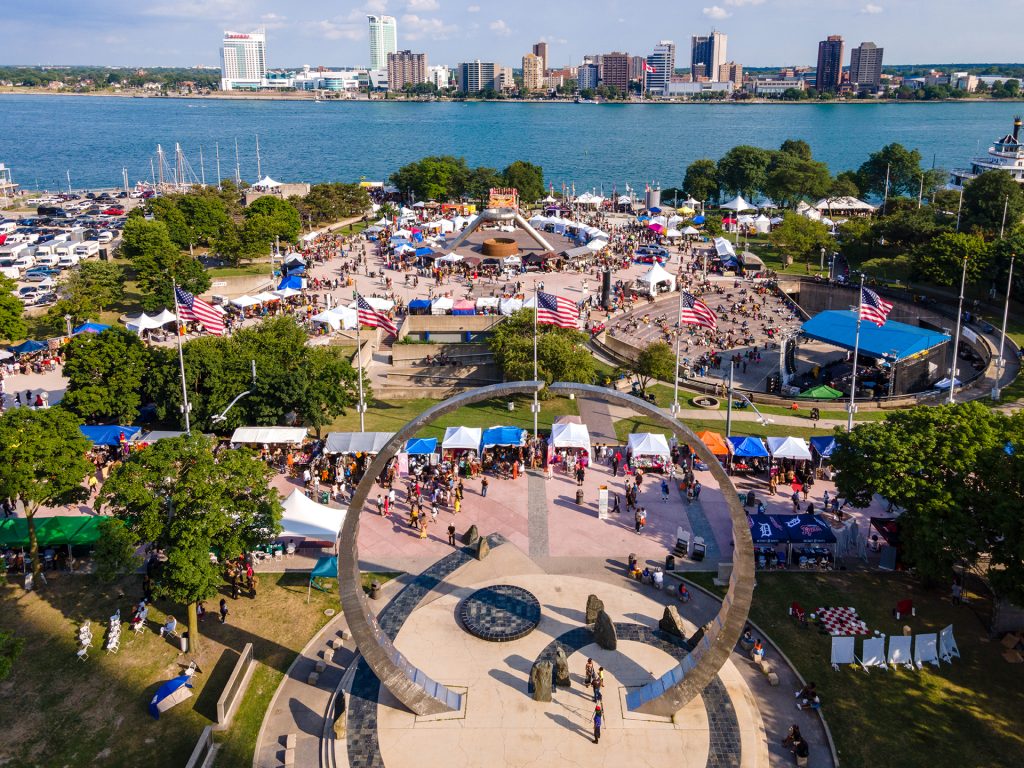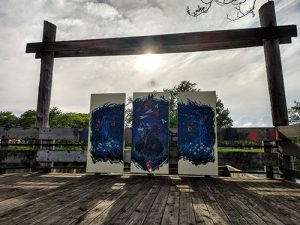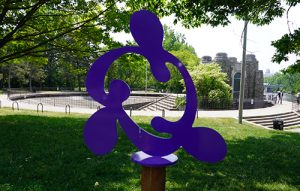By Mary McGuire
In the second part of our series on the intersection of public art and public health, we continue with a placemaking statement through a monumental work of art created by internationally known Detroit-based sculptors David Barr and Sergio De Giusti. Their sculpture “Transcending” rises 63 feet into the sky in the form of two stainless steel arcs that intentionally do not meet.

“Transcending” pays homage to Detroit’s industrial might and symbolizes Labor’s unfinished work. Designed for the Michigan Labor Legacy Project in 2001 and completed in 2003, the 8-ton sculpture is considered the largest monument in the nation dedicated to honoring workers. Detroit’s labor unions commissioned the work to commemorate Detroit’s 300th birthday and it is said the monument includes a time capsule filled with labor mementos from the early 21st century.
“Transcending” can be viewed from its place in Hart Plaza while driving down Jefferson Avenue due to its sheer scale. Though, the only way to experience it fully is to park your car and enter the plaza where Barr’s sculpture stands firmly on mounds of granite carved by De Giusti. Both men were inspired by the works of those who came before them, the identities and contributions of other artists who created works across the city of Detroit, and by the labor movement and workers they were commemorating.
De Giusti wrote, “It is an honor to be in the company of other sculptors of different nationalities who created monuments for the city of Detroit. Robert Graham, who is Mexican American, did the Fist. Ed Dwight, who is African American, made the Underground Railroad sculpture nearby and in Windsor. The incredible Japanese American, Isamu Noguchi created great symbols in Hart Plaza — the Dodge Fountain and Pylon. His influence was important to both Dave and me, in that we wanted our work to properly co-exist and relate to his simplicity of design. Many Italians are also represented in Detroit. Down the street is the Columbus bust by Augusto Rivalta, and the Dante sculpture on Belle Isle is by Raffaello Romanelli. I am Italian, David Barr is English, and we are proud to have worked together to create this new public art.”
Barr wrote, “My challenge was to translate Labor’s ideals into vibrant and fresh metaphors. I began with images and forms of sacrifice and defiance—a circle that defies the architectural grid of rectangles around it, with stones of ancient history that could only be split open and polished by Labor’s ingenuity and will, a spiral that flows from an opened circle, and bronzes that express the historical sacrifices of workers. Wherever we look, we see the victories of organized labor: the buildings, the roads, the automobiles, the electrical system, the water system, the treatment of the air we breathe, our education and that of our children, the care of our elderly, the food on our tables, our medical care, our safety and well-being.”
With this thoughtful approach to their work, they have created a monument that truly signifies how the labor movement in Detroit rises beyond ordinary limits. From the materials used to the magnitude of the sculpture, they represent the triumph of labor and how workers have expanded, and continue to expand, their own boundaries through innovation and sacrifice to support society. In this way, “Transcendence” is an apt name, as the sculpture goes beyond being a standard work of art as it represents triumph that surpasses ordinary limits in both metaphor and physicality.
“Transcending” has been at the center of concerts, festivals, gatherings, and events for the past two decades. Hart Plaza is also a notable concrete playground where “Transcending” reigns supreme in the sightlines of the world’s top athletes who gather to celebrate Detroit’s urban background and compete in the Red Bull Hart Lines skateboard and Red Bull Heavy Metal snowboard competitions.
Creating a Legacy
While Barr was creating this work on Detroit soil, he was also creating an art park in the forest where “…artists could tell the story of our state in and through the fundamental materials of nature… a place that expresses Michigan’s history through the arts.”
Barr traveled to Northern Michigan in 1996 to find a place to fulfill his vision and tell the story of Michigan’s history in a more vibrant way. He found a 30-acre nature preserve at Crystal Mountain Resort in Thompsonville and began to carefully curate the land into an outdoor sculpture forest, which is known today as the Michigan Legacy Art Park. Today, this blended gem of nature meets art gallery features over 50 works of art by Michigan artists along with dozens of stones carved with Haiku poetry for contemplation. It is all set under a towering forest canopy that can only be viewed by hiking through about two miles of rustic wooded trails.
One of Barr’s early works, “Big Two Hearted,” juxtaposes a variety of Michigan themes; the Two Hearted River in the eastern Upper Peninsula, American writer and journalist Ernest Hemingway’s 1925 short-story “Big Two-Hearted River,” set in the same location, and Michigan’s state fish, the brook trout. Michigan Legacy Art Park writes the installation was created to “graphically pay tribute to Ernest Hemingway’s Michigan connections and his pure, elegant writing about Michigan’s natural beauty.” This sculpture is also commemorative as it was created to honor the 100th anniversary of Hemingway’s birth. Yet it does more; it ties Barr and Hemingway together as both were fascinated with the connection between human beings and nature’s restorative properties. As the viewer approaches “Big Two Hearted” there is a series of large rocks leading up to reveal the trout sculpture. Each large rock is carved with excerpts from the short story. This active engagement from walking the path and reading the story excerpts intentionally reels the viewer in to become intertwined with the story.

As the viewer walks along the riverbed towards the trout, they are walking the path with Hemingway’s semi-autobiographical character Nick Adams – a soldier traumatized and broken from serving in World War I – who returns home and heads to the woods for a camping trip. And like the story, here, in this forest, nature turns to nurture.
As the experience unfolds, and as the trout is revealed, the viewer’s excitement rises – like Adams’ excitement in the story. Barr is demonstrating the journey and power of nature to give life and sustenance, much like Hemingway did. And both men illustrate how nature can restore one’s spirit.
Barr is deliberate in the way he mixes storylines and juxtaposes it through this work of art. Just as he did with “Transcending” in Hart Plaza, Barr invites the viewer to experience his work as a witness into the mind of the artist, the subject, and the location, all firmly rooted in Michigan soil.
“There is something incredible about walking through the forest setting amidst the filtered light streaming down with the sounds of birds singing as each work of art reveals itself,” said Michigan Fitness Foundation President and CEO Amy Ghannam. “By having this immersive experience, our senses are awakened. It is the intersection of art, storytelling, nature, recreation, and Michigan history that Barr has created for us that makes the Michigan Legacy Art Park a world-class experience.”
When viewing the sculptures at Michigan Legacy Art Park, the pace is meant to be leisurely, and everyone is encouraged to take their time to explore art and experience nature. The park also has an “all access trail” that meets ADA slope and surface standards and plenty of opportunities for families to bring a picnic and their pups to make a day of it. This family-friendly blend of recreation and culture is the perfect antidote to the screen-related sedentary lifestyle that has become all too common today.
At Michigan Legacy Art Park, the story of Michigan keeps unfolding from the minds and hands of Michigan artists with each step. Altogether it creates a sense of connection. A nonprofit, the Michigan Legacy Art Park’s mission is to inspire awareness, appreciation and passion for Michigan’s history and culture through the arts. Open from dawn to dusk daily, this is a must-see destination. To plan a visit and learn more about the art, upcoming events, concerts, and programs, visit michiganlegacyartpark.org.
Revitalizing Public Spaces with Art
Further south, there is another outdoor space that is bridging art and nature. In Michigan’s capital city, the Lansing River Trail has been connecting local communities and making it possible for people in the region to live more active lives. In 2017, the Lansing Art Gallery & Education Center connected with the City of Lansing to bring the ArtPath River Trail Exhibition to the region. It was such a success that is now an annual event. And, as a result, permanent installations have been added each year.
Over three miles of the Lansing River Trail have been transformed into an outdoor art gallery that, like Michigan Legacy Art Park, features Michigan artists. ArtPath is filled with murals, paintings, sculptures, and fiber installations installed along the trail in the heart of downtown Lansing. Like the Detroit RiverWalk, families can experience a stroll along the river that blends art and physical activity. And, like the Dequindre Cut Greenway, the murals have become integral to the trail. And like both, ArtPath has revitalized formerly blighted places into vibrant public spaces filled with art.
“What I really like about murals is that there’s no gate keeping. Everyone can feel like they can come up close to the art. It’s not just the select few who go to galleries,” explains ArtPath artist Stephanie Ellis.

Last year over 80,000 visitors experienced ArtPath, though scores of people use the 20-mile trail year round. The murals have become so popular that they have become intertwined into the community, showing up across social media as the backdrop to important events and especially for graduation, engagement, and wedding photo shoots.
A unique aspect of the ArtPath murals is that while they are viewable by walking, biking, or rolling along the paved trail, the murals are also viewable from the Grand River by kayak and canoe. Viewing art in nature also invites people to think about the environment they are in and how that environment is being cared for, which is especially visible along a river environment. It is this urban trail along a river with a rich canopy of trees and lush greenery that ArtPath is situated on that makes it distinctly different from any other art installation in the state.
“For the past five years, my family and I have taken our bikes along the Lansing River Trail taking in a new, amazing experience of ArtPath each summer,” says Greater Lansing resident Maggie Okponobi. “Together, we share the experience of being outside, enjoying nature, and art by stopping at each art piece to read about it, learn who the artist is, their vision, and what we think of it. A few of our favorites have been the murals and the pieces that educate about the environmental actions of keeping our rivers clean. This is an event that has brought so much joy to our family and so many in the community. ArtPath is a must-see!”
There is something special about immersing oneself in art, whether you are viewing it, or the artist creating it. ArtPath artists also find themselves wrapped up in the surroundings and find inspiration from viewing each other’s works.
To visit ArtPath, download a map, and/or attend an artist talk, visit lansingartpath.com.

Accessible Art
Unlike art that is held in cultural institutions with operating hours and admission fees, public art is free to view, and can generally be viewed without typical time restrictions. It provides the community with the freedom to choose when they want to interact with the art, and how. The art becomes part of the community and at any point in time, depending on who is viewing it, can tell a story of the past, present, or future.
Enhancing places where people can be active creates places where people want to spend their leisure time, and that is good for public health. Communities like Detroit, Thompsonville, and Lansing show that building partnerships that bring the great outdoors and arts initiatives together is possible. This kind of cross-sector collaboration is a compelling example for other community coalitions to consider when developing partnerships to build an active community.
“This intersection of public health and public art is creating inspiring places that support healthy living. We encourage everyone to get outside and take it all in and look forward to experiencing more of this in our communities in the years to come,” says Ghannam.

